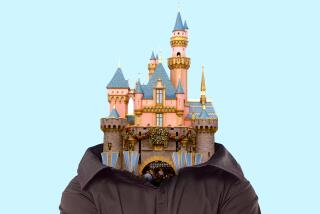Scarysaurus: Is ‘Jurassic Park’ for Kids? : Despite Dino-Sized Merchandising, Studio Advises Parental Guidance
- Share via
With millions of toy replica dinosaurs, games, books, candy and other licensed “Jurassic Park”-related products flooding the stores, many parents are likely to feel plenty of pressure this summer from young offspring clamoring to see the PG-13-rated film.
So the big question is: Will “Jurassic Park” be dangerous to your child’s mental health? Executives at MCA Inc.-owned Universal Pictures and director Steven Spielberg’s Amblin Entertainment Co. say parents should take the rating seriously and decide for themselves. “It will be too intense for some children, but that doesn’t mean it’s too intense for all children,” said MCA Motion Picture Group Chairman Thomas J. Pollock. “If parents are concerned (about the violence in the film) they shouldn’t take their kids.”
Pollock said there is no way to spell out an appropriate age for viewing “Jurassic Park.” “Finally it will depend on the maturation level of the child.”
*
But Amblin marketing vice president Brad Globe was more specific: “We have been very careful not to create the impression that this movie is for young children,” he said. “I would not take a young child of 7 years old. It’s fine for a child 8 years old.”
Nevertheless, many of the tie-in products made by more than 100 licensees are targeted for young children, who are also likely to be drawn by the blitz of television advertising. The heavily hyped “Jurassic Park,” which opens with many late screenings tonight before a full release Friday, abounds in scary incidents. A tyrannosaurus overturns a disabled electric car in which two children are sitting. A paleobotanist grabs a human arm and realizes to her horror that it is not attached to a body. Vicious velociraptors are on the loose.
But in contrast to Michael Crichton’s novel of the same name--in which people are eviscerated by velociraptors--the movie contains nothing gory or graphic. Much of the violence occurs offscreen. And the menacing creatures are imaginary prehistoric reptiles, not other human beings.
“If it was Hannibal Lecter who was doing all these things, including the eating of people, that would be real and not appropriate,” said Pollock, referring to the psychotic villain of the R-rated 1991 film “Silence of the Lambs.”
Devised by the Motion Picture Assn. of America, the PG-13 rating “strongly” advises parents that “some material may be inappropriate for children under 13.” The MPAA’s rating brochure states: “In effect the PG-13 rating cautions parents with more stringency than usual to give special attention to this film before they allow their 12-year-olds and younger to attend.” But many parents are likely to ignore the warning, exhibitors say. “It doesn’t have an R rating, so parents are not going to be restrictive on this,” said Michael Patrick, president of Carmike Cinema, which has 1,560 theaters in 25 states. “In our market you will see kids in kindergarten being brought to see this movie with their parents.”
Making it harder for parents is the tremendous popularity of dinosaurs--even before the craze for television’s lovable “Barney”--among younger children. Even before the movie had hit the screens, some area toy stores were already reporting strong sales of licensed products. “We sold 75% of what we got in,” said Frank Trader, assistant manager of Play Co. Toys in Ontario.
“(The merchandise) is clearly a problem,” said one theater chain executive who wished to remain anonymous. “It creates a want-to-see. And parents are going to have to say no.”
But Amblin’s Globe said the movie-related products were inevitable--whether licensed by Universal and Amblin or not. “Kids want to buy dinosaur merchandise,” he said. “It’s very important that we protect our copyright and anticipate the demand.” Licensed products range from free McDonald’s soda cups to $40 dinosaurs with removable skin.
McDonald’s Corp. was criticized last year for offering special children’s meals promoting the PG-rated and violent “Batman Returns.” The company has said its “Jurassic Park” tie-ins--”Dino-Sized” meals, collector cups and restaurants transformed into the “official visitors’ center” shown in the films--are aimed at adults.
For parents unable to withstand the pressure, some psychologists offer comforting advice. They say that scary movies are not necessarily bad for children--as long as the parent is available to discuss the experience afterward.
*
“What’s important is that children get to process what happens to them, to understand the difference between what is real and fantasy,” said Irene Goldenberg, a family psychologist at UCLA Neuropsychiatric Institute, who, like others interviewed, had not yet seen “Jurassic Park.”
Alan Entin, a family psychologist in Richmond, Va., compares scary movies to Grimms’ fairy tales, and says both can be valuable for children’s emotional growth. Children between 5 and 8 years old “are dealing with issues of growing up and independence and competence” and are ready to handle movies showing the world as a dangerous place, he said.
“These movies can really help kids to work out their own life situations” by providing them with a way to discuss their fears about the world, said Entin, who studied with the late Bruno Bettelheim at the University of Chicago.
Stuart Fischoff, who teaches media psychology at Cal State L.A., points out that many adults can vividly recall how frightened they were as children when they saw Bambi’s mother killed by hunters. “There’s no question that (these stories) become part of a child’s repertoire of fears,” he said.
But he said that nightmares that result from these fears may have a beneficial effect by making a child’s “free-floating anxieties” easier to discuss and manage, as long as parents are on hand to hear about them.
Still, he cautioned: “The parent has to know the temperament of the child. If the child is hysterical, if everything scares them, then I’d say no (to the movie).”
More to Read
The biggest entertainment stories
Get our big stories about Hollywood, film, television, music, arts, culture and more right in your inbox as soon as they publish.
You may occasionally receive promotional content from the Los Angeles Times.










